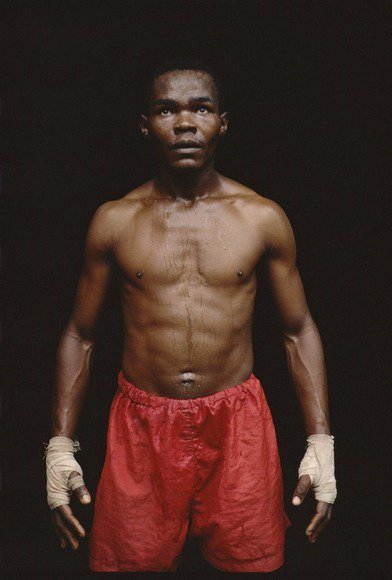Philippe Bordas
dal 12/6/2013 al 16/8/2013
Segnalato da
12/6/2013
Philippe Bordas
Galerija Fotografija, Ljubljana
Heroic Africa The Mali's hunters. This exhibition is not a story about sport. But more profoundly, the contest becomes a metaphor. The concerto of kenyan ascetic fighters and the opera of senegalese wrestlers are revealing the 2 opposite sides of a continent.

Protected by amulets and grigris, equiped with old rifffles, they represent a pure african and preserved memory.
Holding the legacy of the former mali empire, they are wearing same clothes and they are obeing the same laws than horsemen and soldiers of the Soundiata Keïta king (1190-1255). The malian hunters are ignoring the borders born from colonisation and they are living on the full space of west african, on Mali, Senegal, Gambia, Guinea, Mauritania and a part of Ivory Cost. They are transmitting the oral story of the malian empire of Keïta, wich was covering a large space from Sahara to equatorail forest, from atlantic ocean to the end of Niger river.
The time of Keïta was a period of relative peace and prosperity, during which islam et animism were coexisting. After centuries of tribal wars and slavery, Keïta put together the armies of the small kingdoms and took over his rival Soumahoro Kante in 1235. He put the foundation of the capital in Niani, in Guinea, close to the malian border. The Donzo Ton (Ton is a Mandé word for age-group, religious, or vocational associations) are but one of a number of hunter fraternities common in Mandé-speaking areas of West Africa. Similar, and in the case of West Africa closely related groups, exist as the Kamajor in Sierra Leone, Poro in Liberia, the Mayi-Mayi in Democratic Republic of the Congo, and the Karamojong in Uganda. Sons of Dozos, as well as new adherents, are able to be initiated into the Ton, and undergo a series of secret rituals.
There has been a long history of these hunter collectives (the Segu Bambara empire is said to have grown from such a Ton) and hunters were often viewed by farming or pastoralist neighbours as possessing special power, wisdom and strength. Collective organisations, as with many vocations in West Africa, existed in part to train and pass on needed skills. Hunters, though, are found in every community, and are not a strictly inherited role. It is believed that the amulets (gris-gris) worn by Dozos possess magical properties protecting them from harm, and amplifying their vision and hearing. Such amulets, inherited brown hunting clothing, as well as special hats, are said to make them bulletproof. Each local Donzo Ton is led by an elder hunter, the donzokuntigi. Along with ritual and initiation, local Donzo Ton will meet to discuss their work, organise hunts, or settle internal grievances, often in the all-night tonsigi gathering. In this way, the Donzo Ton operates much like a western guild. Part of the cultural and ritual tradition of the Donzow surrounds sacrifice and protection of the community. In traditional belief, wild animals killed by hunters released a nyama, a destructive spirit which afflicted the community benefiting from the kill.
Donzo Ton trained to perform rituals, cleansing the nyama and enabling them to both share their bounty with the community of non-hunters, and act as spiritual guardians of settled communities from malevolent forces of the forest or bush. The artist discovered them in 2001, in Bamako. About 40 000 hunters from all west african countries met in Mali for the first for more than seven centuries. In 2002, he became friend with an old hunter Sidiki Traore, with whom he travelled to meet some others old hunters.
BARE-FISTED AFRICA: THE KENYAN BOXERS , THE SENEGALESE WRESTLERS
A tour based on photographic images and collected voices of anonymous Africa which few have seen and few speak about. Destroyed by the new economic order and burdened by northern banking system, homeless men survive through the ritual of bare-fisted boxing and wrestling and they become heroes. The boxers of the Nairobi slums live in an Africa that is no longer their own, but a world dominated by modern white civilization, materialism and Christianity. As if summoned by the ghost of Mohammed Ali, the men through their own form of boxing rebel and search for and find a spiritual identity.
The wrestlers of the poor Dakar suburbs are sustained and protected by the drums and themagic words of the marabouts, womenʼs chanting and singing, and traditional fighting poetry.
This exhibition is not a story about sport. But more profoundly, the contest becomes a metaphor. The concerto of kenyan ascetic fighters and the opera of senegalese wrestlers are revealing the two opposite sides of a continent. This work is revealing an unseen definition of Africa, his secret duality.
Opening: Thursday, 13th June 2013 at 7pm
Galerija Fotografija
Mestni trg 11/I, Ljubljana
Hours: tuesday - friday: 12h- 19h,
saturday: 10.00 – 14.00
Free Admission



